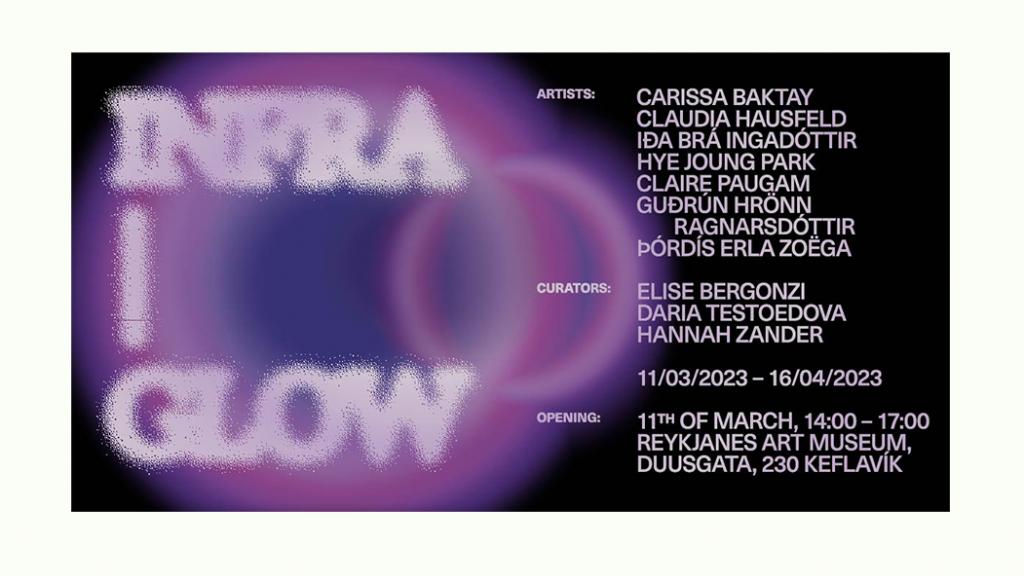INFRA-GLOW
Wandering the land between the inner self and the roughness of the outside, a gap is oscillating back and forth. What lies around us reshapes and impacts our being. Solitary sensations shape our ability to interact with the outside. These intimate feelings can be triggered by our reaction to the slightest progressive changes. Rooted in our daily experiences, the environment has a powerful capacity of expression.
INFRA-GLOW gathers artworks by Carissa Baktay, Þórdís Erla Zoëga, Iða Brá Ingadóttir, Claire Paugam, Hye Joung Park, Claudia Hausfeld and Guðrún Hrönn Ragnarsdóttir, that provoke the intimacy of collective relationships between our bodies, our minds and our surroundings. The idea of imperceptible closeness between us, our mundane surfaces, and their fluid porousness is a starting point.
In Iceland, the gradually polarizing effects on human perspective caused by the summer and winter equinoxes twists our biological clock, highlighting the moments where our surroundings blend with states of intimacy and solitude. Leading up to and during the midnight sun, the illusion of additional time allows for new ground to be covered, a prismatic view where one could reflect, immerse, lie, or rest. In contrast, the eclipsing effect that begins to happen immediately after sunlight hours hits their peak, starts to reel in the peripherals, narrowing awareness through a threshold towards the interior. Organic and manufactured merge, allowing for the sound of our inner bodies to blend with the silence of our daily landscapes.
In Claire Paugam, Carissa Baktay and Þórdís Erla Zoëga’s works, microcosm meshes with macrocosm; mineral and organic blends; body and ore interlace; and the outlines between what is fresh and what is fainted in our memories collapse. From the resulting porousness, new narratives emerge.
Claudia Hausfeld, Guðrún Hrönn Ragnarsdóttir, Iða Brá Ingadóttir and Hye Joung Park bring us somewhere else; to an in-between of inhabited reality and deserted, vanishing horizons. The mind can lose itself in the background of their powerful inner landscapes.
Carissa Baktay cuts into this landscape to reshape its peripheries according to her sensations. Her mirrors are transformed into lakes, reflecting their coloured lights to dissolve the borders of an imaginary realm. In her process, from the seas and rivers to the intimate bathroom, bodies and surroundings hold a central place. Cleaning, washing, taking care; and restoring the value of the hairs she uses in some works until they fit into precious vessels, or glow in a giant braid.
Þórdís Erla Zoëga‘s actions similarly reveal a deep attention to her materials; light and glass. She walks us into a mirrored world, made of mesmerizing, fragile, and vaporous reflections. When she isn’t trying to melt separated bodies into one, she creates installations that seem to collapse and carry with the wind, as if a piece of dawn was about to be scattered by the first glimpse of an endless sun beam.
In between places, Claire Paugam infiltrates the museum space via its threshold. A giant tongue welcomes us inside her inner space; a rock on the other side seals the way. Her photographs lead us through to the edges of her subconscious, where reminiscing images are keeping an evocative narrative of disappearance alive. Within a half-light at the bottom of her memory, her surroundings seem to melt while enveloping us.
In Iða Brá Ingadóttir’s performance, a fluid communication between her body and the vivid natural environment arise. Translating a silent dialogue, the waterfall speaks to her in a ritualistic gesture of empowerment. Linear timelines cease to exist, leaving a blank space for a fluid cohabitation between human and nature. The viewer is invited to rest on a stone or a blanket, where the body may absorb the energies.
Hye Joung Park’s work is also restful. Shapes of paper and ceramics narrate the tale of a shell, forgetting itself on a white beach. In her process a correlative resonance between body and mind crystallizes in a choreographic movement. Introducing a chronicle of the timelessness of materials, the fragility and thinness of Hye Joung Park‘s work resonate with Claudia Hausfeld’s hut. The image and the object are looking at each other, codependent and with benevolence. They protect each other, like a shelter, hiding in the environment of the gallery as well as in nature. Inside and outside collapse again, potentially leaving an in-between.
Within the Hut's sightly purview is another couple, Guðrún Hrönn Ragnarsdóttirs’s reupholstered chairs. Fragments from the outside merge and cling to the typical pair. What was once soft, stable, and made for the purpose of functional comfort, is now an uncertain resting place for the mind to dwell and admire.
Here, in this infra-verse, connections between our inhabited physical and mental spaces take root in an expanded environment to experience new potential narratives of existence. The objects we create and the spaces we wander among to shelter our bodies and imaginations, are attempts to explore a fragment of sensation and invite the viewer to lie in the glow of a persistent twilight.


